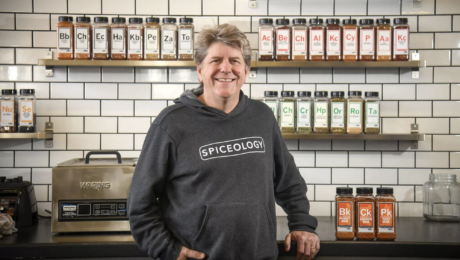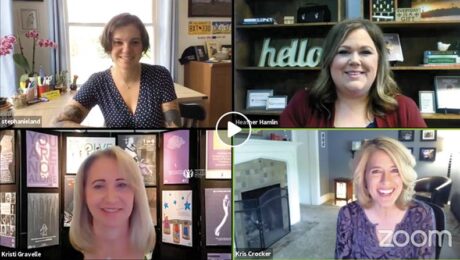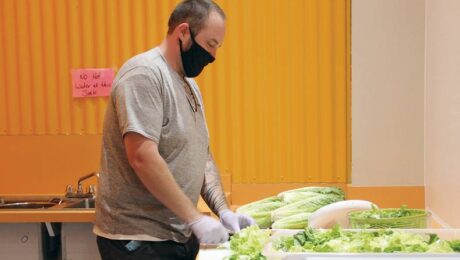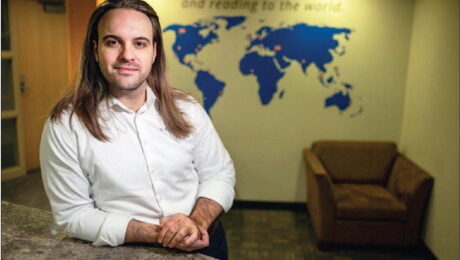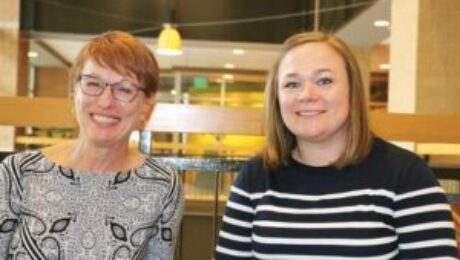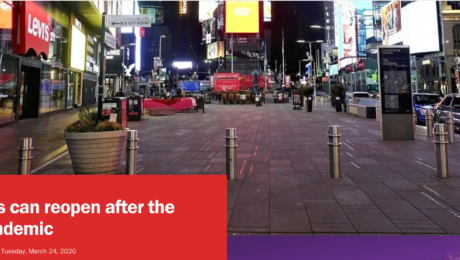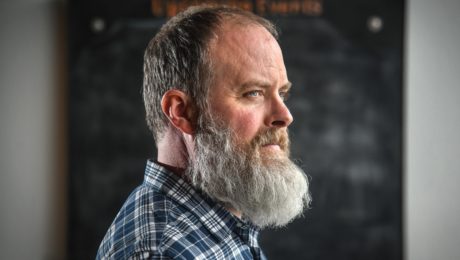Spokane-based Spiceology has secured a $4.7 million round of Series A funding, led by grocery and retail executive Ty Bennett with participation by Kickstart Funds III and IV, a group of angel investors and the Cowles Co., which publishes The Spokesman-Review.
“I have been an investor in Spiceology since the early days and had the privilege of watching the company elevate above the thousands of small spice purveyors in the market,” Ty Bennett, founder and former CEO of Jacent, said in a statement. “I look forward to bringing my retail and grocery experience to the table to help Spiceology continue to delight customers and find new ways of meeting customers where they shop.”
The privately held spice company will use the funding to bring process automation to its SpiceLab operations, and advance its sales and marketing efforts. The SpiceLab is where spice blends are formulated and packaged with the company’s trademarked “periodic table of flavor” labels, according to a company release.
Series A funding is the first round of investment funding after seed funding. It typically involves venture capital firms and is for startups that have established growth.
Spiceology, founded in 2013, was recently named to Inc. Magazine’s list of the 5,000 fastest-growing companies in the nation. It ranked 1,081 on the list with a three-year revenue growth of 423%.
The company has steadily grown its operations by creating recipes and how-to videos for customers as well as collaborating with chefs and food influencers on new product lines.
At the onset of the coronavirus pandemic, Spiceology experienced an uptick in spice sales as more people began preparing meals at home.
Bennett has joined Spiceology’s board of directors. The company also hired Roger Landrum as senior vice president of global supply chain and operations, the release said.
Landrum was formerly the senior director of supply chain, risk management and procurement at Litehouse Foods, a Sandpoint-based $300 million salad dressing and herb manufacturer.
“Spiceology’s formula is focusing on quality and innovation at scale. By doing so, we’re bringing life into a very tired category that’s sorely in need of a fresh alternative,” Chip Overstreet, president and CEO of Spiceology, said in a statement.
“There’s nothing more core to our lives than eating, and we bring smiles to people’s faces when they realize how much better every meal can be with a simple sprinkle of Spiceology goodness.”
This article originally appeared on KXLY.com by Derek Deis
COLVILLE, Wash. — Buildings made with cross laminated timber are already commonplace in Europe, but it’s a relatively new concept here. So to say Russ Vaagen, whose family has owned Vaagen Brothers Lumber for more than 70 years, is excited about his new venture would be an understatement.
“We could put this as the mass timber capital of North America eventually,” said Vaagen, the CEO and founder of Vaagen Timbers.
Cross laminated timber is an eco-friendly, wood panel product made from gluing layers of lumber together. Vaagen says it’s kind of like a Lego set.
“We’re actually putting together a kit that a builder can do very rapidly, high quality and goes together the same way every time,” explained Vaagen. “And so, it’s going to speed construction time up, it’s going to provide a much higher quality build, we’re going to be much more energy efficient.”
Vaagen Timbers can build its CLT panels up to 60 feet wide with varying depths. And Vaagen says it’s one-fifth the weight of steel and concrete with the same structural strength.
“So we’ll have a lighter, more nimble building. It’ll also be much better equipped to handle seismic shifts.”
And Vaagen says it can be used for all sorts of applications, including, “Mid-rise structures for commercial buildings, apartments and even homes.”
CLT panels start with pieces of lumber on the finger jointer machine.
“We take knives and we make a set of fingers. And they do just as it says, they joint together. And then we use pressure and an adhesive to tie those together,” said Vaagen.
After the wood is planed, it goes to the layup line, where Vaagen says those pieces of lumber get turned into panels.
“So we take four feet of wood, we lift it up all together, put it on the conveyor, goes and gets a layer of glue.”
A set of vacuums then lifts and places each additional layer.
“Sets it on top of that glued layer 90 degrees to the other layer, comes back through the glue, gets another long layer set back on it.”
The now heat cured panels then get cut by giant saws on the CNC line.
“We’re cleaning the cuts, we’re making the connections to go panel to panel if we’re doing a wall or a floor system,” said Vaagen.
After sanding, they’re ready to be shipped to customers.
One of the first places you’ll be able to see Vaagen Timbers’ CLT put to use is in Spokane’s Perry District, where Blockhouse – Life is building a 14 unit modular structure using CLT.”
“So we’ll make boxes basically that can be repeatable, but they can be customized,” said Vaagen. “And it’s modular. So ultimately, you could pick it up and move it and put it someplace else.”
Vaagen says Spokane, and Washington as a whole, are poised to be leaders in CLT and mass timber products. And that has him excited about Vaagen Timbers’ potential for growth.
“There’s just no losers. Everybody wins. And we’re going to be offering incredible structures for people to build with for years to come.”
The following are projects, initiatives and economic developments are making news in eastern Washington and northern Idaho.
*************
SPOKANE, Wash. — Washington Department of Commerce has provided a $100,000 grant to support expansion and workforce training needs of SkyOne Aerospace. Founded in the Spokane Valley in 2015 with three employees, SkyOne Aerospace, specializes in customer-oriented repair and overhaul of instruments, avionics, electronics, mechanical units and hydraulic units of military aerospace aftermarket. SkyOne will purchase new equipment to meet expansion needs and hire additional skilled technicians with military aerospace experience. The company will retain 18 jobs and create 45 new jobs over the course of the next three years. Presently, 40 percent of SkyOne’s workforce are veterans, and the company is committed to hiring more, mostly from Fairchild Airforce Base. Read more on the SkyOne website.
COEUR d’ALENE, Idaho — Idaho Central Credit Union, ranked 2nd by Forbes’ 2020 Customer Satisfaction Survey, opened a branch in Coeur d’Alene at 1327 W. Appleway Avenue. This is Idaho Central’s 38th location in Idaho. The 8,600-square-foot branch has a drive-through with three lanes, an ATM and a video booth in the corner for members to access our VideoChat services. See more about ICCU’s Appleway Branch here.
PULLMAN, Wash. — With the recent successful completion of the $155M runway realignment project at the Pullman-Moscow Regional Airport (PUW), work recently began on the design and construction of a new terminal. In early August, the PUW Airport Board created a Terminal Advisory Committee to help gather community feedback and help shape the design of the $35 – 50M project. Committee members include community and university officials, key business leaders and other interest. Contact the PUW for more information.
MOSCOW, Idaho — Work continues on identifying and developing additional water supplies for the Palouse Region. Under the direction of the Palouse Basin Aquifer Committee (PBAC), an organization which includes the cities of Pullman, WA, and Moscow, ID, Latah and Whitman counties, University of Idaho, and Washington State University, a $150,000 contract was recently awarded to Alta Science and Engineering, Inc., of Moscow, ID. The study will focus on refinement of potential water supply alternatives as well as interim measure to help identify and develop additional water supplies within the Palouse Basin. Contact PBAC for more information.
SPOKANE VALLEY, Wash. — The Spokesman-Review has moved its printing operation to a new facility in Spokane Valley. It is now being printed on a press that was built in the early 2000s, and used to print the New York Times in Ann Arbor, Michigan. A second press, expected to come online this summer, will give the new company, Northwest Offset Printing, a way to print magazine-quality products. Read more in this Spokesman-Review article.
KELLOGG, Idaho —The Silver Valley Community WIFI CO-OP has recently launched to provide community Wi-Fi and free internet connections to Kellogg, Wallace, Pinehurst and Cataldo for residents to do remote learning, apply for essential services, pay bills, and perform other essential tasks. See more at https://www.svwifi.org/home.
SPOKANE VALLEY, Wash. — Spokane-based GL8 Hospitality LLC is breaking ground this week on a Tru by Hilton property in Spokane Valley, marking the brand’s first in the state. The 43,000-square-foot, four-story building will be at 13509 E. Mansfield Ave., east of CenterPlace Regional Event Center. The hotel, which will have 92 guest rooms, is expected to open in November 2020. See the full story here.
LEWISTON, Idaho – The Port of Lewiston welcomes Tsceminicum Bottling Company as its newest tenant. The full-service beverage and bottling factory produces Artesian Fusion Brand products in Aluminum, 500ml PET and PHA fully biodegradable plastic bottles, using water directly from their own Artesian well located at their factory, providing nutrient rich minerals from a deep and ancient aquifer. The bottling factory located on Colonel Wright Way will create eight full time and two part time jobs. Artesian Fusion brand products will be available in regional grocery stores and distributed through Idaho. More on Artesian Fusion here.
SPOKANE, Wash. — Palo Alto, California-based electric car manufacturer Tesla Inc. has established a service center in East Spokane. The company is planning to install 10 more superchargers in Washington, according to its website. Electric vehicles have grown in popularity in Washington in recent years, with over 42,500 plug-in electric vehicles registered in the state as of December 2018, according to the Washington state Department of Licensing. Over 810 of those were registered in Spokane County. Read more here.
MULLAN, Idaho — Lucky Friday mine, located near Mullan, produced 568,537 ounces of silver in the second quarter of 2020 and expects to reach full production by year-end. Lucky Friday is owned and operate by Coeur d’Alene-based Hecla Mining Co, and is the closest mine to Spokane. A Canadian company is a new investor in Hecla. Hecla Mining Co. has silver mines in Idaho, Alaska, and Mexico, as well as gold mines in Nevada and Quebec. Read the full article in the Journal of Business.
SPOKANE VALLEY, Wash. — Etailz has secured $25 million in debt financing to develop new products, expand inventory and grow retail partnerships. The new round of financing will specifically allow the Spokane Valley-based company – which partners with third-party sellers to grow their brands on Amazon, eBay and Walmart – to improve its proprietary software that discovers product trends, identifies new distributors and optimizes price positioning decisions. Etailz was founded in 2008 by Gonzaga University graduate Josh Neblett, his wife, Sarah, and angel investor Tom Simpson. Trans World Entertainment, a publicly traded company, acquired etailz in 2016 for $75 million. Etailz relocated to its 40,000-square-foot Spokane Valley headquarters in 2018. Read more here.
************************
Inland Northwest Economic Alliance (INEA) is a consortium of fourteen economic development agencies representing fifteen counties in the North Idaho/Eastern Washington region. The collaborative effort is aimed at building economic growth through enhancing the brand recognition of the Inland Northwest and its communities and showcasing its business value. To learn more, visit www.inlandnorthwestregion.com.
Article first appeared in Spokane Business Journal, July 30 2020. Written by Virginia Thomas
Socially distanced, socially conscious
Some nonprofits switch to longer fundraising cycles, spend less on overhead
Instead of canceling fundraising events, many Inland Northwest nonprofits have moved them into the digital realm.
Donor participation in charity events is lower, but some nonprofits say they’re receiving nearly as many donations as in prior years from a smaller pool of donors, and nonprofits are saving money by forgoing costly in-person events in favor of low-cost online affairs.
Heather Hamlin, executive director of Women Helping Women Fund, says her staff saw the writing on the wall by mid-March. The organization had planned its 28th annual luncheon for May, but Hamlin and her staff knew well before then that in-person events wouldn’t be possible for several months, at least.
“But the need in the community was bigger than ever,” Hamlin says. “We saw that was going to continue to grow, so we decided to move to a virtual event.”
Women Helping Women Fund decided to change to a longer, eight-week fundraising campaign in which table captains set goals for their groups, who raised money through networking. Keynote speaker Stephanie Land spoke to the organization through a Facebook Live event, which Hamlin says has garnered more than 13,000 views.
Hamlin says Women Helping Women Fund received about $170,000 in private donations in its eight-week campaign, as opposed to the $300,000 the annual luncheon typically generates. Hamlin says corporate donations go to underwriting the event, so Women Helping Women Fund receives every dollar donated by individual donors.
Lutheran Community Services Northwest’s fundraiser was a different story. The annual 8 Lakes Leg Aches bike ride fundraiser, which typically results in about $75,000 in donations, raised about $80,000 in this year’s “virtual ride.”

Clockwise from top left, Stephanie Land, Heather Hamlin, Kris Crocker, and Kristi Gravelle participate in Women Helping Women Fund’s virtual event.
The 22nd annual biking event had been scheduled for June 22 but was rescheduled for July 18. Development manager Christie McKee says the organization had thought an in-person event might be possible. By July, it was clear that wouldn’t happen, and the organization decided to make 8 Lakes Leg Aches a virtual event.
Attendees were invited to complete one of three rides, with routes that were 30, 45, and 70 miles long, on the course of their choice, or even on a stationary bike, between July 11 and July 18. A finish-line event was held via Facebook Live on July 18.
McKee says ridership was down this year, to about 200 participants from nearly 600 riders in past years, but she says she was impressed by the support those 200 riders provided to the organization.
“We had one pledge rider who raised $9,900 who is 90 years old and rode 17 miles to celebrate his 90th birthday,” McKee says. “We had a few others who were able to raise $10,000 each, and several that did $3,000 or more.”
McKee says most riders are from outside of the Spokane area, which was part of the reason for encouraging participants to bike any course. But it also meant that overhead for the fundraiser was much lower.
“Usually, if we have David’s Pizza at the event and we have 600 riders, our bill’s going to be for 600 riders,” McKee says. “We have roughly 160 riders who are here in this area. The others are all out of town, so they’re not even going to go to David’s Pizza.”
McKee also ordered about half as many T-shirts as usual for the event, expecting that participation would be lower.
“We’ll actually net more this year, because our expenses are going to be lower,” McKee says.
Amy Knapton Vega, executive director at Vanessa Behan Crisis Nursery, said that when she was trying to decide how to pivot the organization’s annual June benefit luncheon, she was told by some that the organization shouldn’t expect to raise any money from events.
But Vega watched as other organizations held successful fundraising events, and she decided to forge ahead. She asked for help from longtime partner Hamilton Studios, which helped the organization put together a virtual benefit luncheon.
“They helped us navigate through what would work, how to tailor it, and they did a great job of doing their own set up, as far as social distancing,” Vega says.
The online event drew 300 viewers, in comparison to the roughly 1,000 people who usually attend the luncheon. But Vega says the exceeded its goal of $170,000, bringing in a total of $172,000.
Going virtual saved Vanessa Behan Crisis Nursery thousands of dollars. Vega says the luncheon usually costs the organization about $40,000. This year, the crisis nursery spent less than $5,000 for its online event.
Don Hamilton, owner of Hamilton Studios, says he started adapting his video production and photography studio into a socially distanced, livestream-capable studio in March. A friend was scheduled to deliver a lecture to a college in Virginia in late March and decided to do so via Zoom. Hamilton thought his friend deserved better than a bland setting.
“It got me wondering — how could I use my cameras, lights, mics, and large studio to safely offer my friend a high-production-value presentation?” Hamilton says. “I started looking into the technology to adapt my motion picture production equipment to support a multicamera, livestreaming studio.”
Hamilton asked the Spokane Regional MarCom Association if he could handle the nonprofit organization’s annual Spark awards event to prove he could do a hybrid virtual event that combined livestreaming with pre-recorded segments.
“They were game, so we started by producing a glossy teaser announcing the event,” Hamilton says. “We then had a number of members of the MarCom board come in, one at a time, to pre-record announcements of the winners.”
Hamilton says the event was a success.
“The show moved seamlessly between pre-recorded packages and the live hosts reading a script from a large studio teleprompter,” he says.
Since then, Hamilton Studios has handled five livestreaming events, including the Vanessa Behan luncheon and YWCA Spokane’s “An Evening in Tuscany” fundraising event.
Social distancing at Hamilton Studio is easy, he says. His studio is located in the former auditorium of St. Joseph Catholic School, and he’s divided the basketball court in half.
“The idea is that whatever we do in there, we get one half-court for the crew and one half-court for the talent, so that nobody’s ever closer than 15 feet,” Hamilton says.
Hamilton says no more than seven people are in the studio at any one time. When a livestreaming event is taking place, just three crew members run the show: Hamilton and his wife, Lorna, sit together at the master controls, where Lorna manages the teleprompter, and Hamilton manages four live cameras in addition to pre-recorded videos. About 25 feet away from master controls, video editor Hannah Sander becomes the live program manager during livestreaming events.
Hamilton says he believes it will be at least another two years before nonprofits can return safely to holding in-person events. In that time, he expects demand for hybrid livestreaming events will increase exponentially.
“I’m already lining up more things,” Hamilton says.
Dana Morris Lee, chief philanthropy officer at YWCA Spokane, says the organization’s livestreaming of its 14th annual Tuscany event surprised her in that it required so much more technical effort and volunteer participation beforehand, as compared to in-person events.
“We had to become virtual experts as quickly as possible,” Morris Lee says. “You need to have a location to do this, and you need somebody who understands the technical restrictions around sound and video, and how to switch between different components of the program.”
An Evening in Tuscany typically draws about 400 people, Morris Lee says. About 200 people watched the livestreamed event.
The fundraising portion of the event was stretched from one night to about six weeks. Morris Lee says the organization decided to do a longer fundraising campaign after watching and learning from other organizations’ events.
“Creating a longer-term fundraising campaign around the event was a critical piece, because you just aren’t going to get the same attendance online that you’re going to get in person,” Morris Lee says.
YWCA Spokane had hoped to raise $100,000. As of July 20, the fundraising campaign had received about $75,000. Now, Morris Lee says she hopes to reach $92,000 by Friday, July 31, when the campaign ends.
While an online event can provide a nonprofit with some funding, Vega says she still missed being in a roomful of people who have a long-standing relationship with the crisis nursery.
“It always feels like you’re going to a kind of reunion,” she says. “It’s always so fun to get to visit and catch up on things, and we just didn’t get that luxury this year. That was probably the hardest part of it.”
This article first appeared in the Spokane Journal of Business on August 13 2020. Written by Virginia Thomas.
An emerging restaurant model known as “ghost kitchens” is gaining popularity in some parts of the U.S. and could find a foothold in Spokane, industry experts say.
The concept appears to be becoming more appealing as COVID-19 pandemic-related restrictions continue to batter the restaurant industry.
Ghost kitchens refer to restaurants that operate exclusively on a takeout-and-delivery model, without in-house dining. There are three types: commissary kitchens, pop-up kitchens, and pods, according to digital food-tech publication The Spoon. Commissary kitchens are shared kitchen spaces owned and operated by a third party. Popups are areas within the main kitchen of a restaurant that are dedicated to fulfilling pickup and delivery orders and typically have a distinct menu and branding from that of the established restaurant. Pod kitchens operate within shipping containers and can be placed nearly anywhere.
Adam Hegsted, owner of the Liberty Lake-based Eat Good Group LLC., says the company had planned to open a ghost kitchen space in Spokane Valley, but it’s holding off until the area’s economy stabilizes.
Hegsted says Eat Good’s partner, GVD Commercial Properties Inc., bought the former liquor store building at 5004 E. Sprague earlier this year. Hegsted planned for four companies to share the space: Incrediburger & Eggs, Taco Suave, Doughlicious Bakery, and either a fried chicken or healthy food restaurant.
Hegsted has experience dabbling in the ghost kitchen model. Eat Good Group’s cafe, located in the Meadowwood Technology Campus, in Liberty Lake, also produced orders for Incrediburger Express, a takeout- and delivery-only version of Hegsted’s hamburger restaurant. That has been suspended temporarily, partly due to the impacts of the pandemic, Hegsted says.
“The idea works great, as long as you can get enough delivery orders,” Hegsted says. “There’s a lot of savings as far as the buildout. And same with labor. You don’t have to have as many front-of-the-house people doing customer service and helping guests. You just have a cook back there to create the food, and someone getting orders ready, taking orders, and cashing people out.”
Adam Stinn, director of business solutions at Rosemont, Illinois-based national foodservice distributor US Foods Inc., says the idea was catching on in some U.S. cities before the pandemic struck, but it’s become an important way for entrepreneurs to launch their food businesses, as well as a way for existing sit-down restaurants to add another revenue stream to compensate for lost revenue due to COVID-19-related occupancy restrictions.
“We have seen growing popularity and growing interest across all segments around ghost kitchens,” says Stinn, whose company operates the Food Services of America warehouse in Spokane. “I’ve seen some numbers saying that in the next 10 years, this could be a trillion-dollar industry. There’s definitely a lot of growth potential.”
Ryan Wilcockson, owner of Spokane Salad Delivery LLC, says he chose to use a ghost kitchen model to start his salad delivery business in order to keep overhead low. Wilcockson, the sole employee of Spokane Salad Delivery, works out of the Kitchen Spokane commissary space in the Northtown Mall.
“They have all the supplies we need, all the fridge space, freezer space, and dry (ingredient) space,” Wilcockson says. “It saves a lot, and I can afford to buy fancier products for the customers.”
Kitchen Spokane is a nonprofit that offers commissary kitchens as incubators for small food businesses. Jayme Cozzetto, director of Kitchen Spokane, launched the first commissary kitchen under the Kitchen Spokane name in 2014. Since then, it’s grown to include two locations in Spokane, two in Coeur’ d’Alene, one in Ponderay, Idaho, and another in Vancouver, Washington. Most of its commissary kitchens are in malls.
Donita Humrich, kitchen manager for Kitchen Spokane, says malls are a good fit for commissary kitchens because the infrastructure already exists, and clients can access the space at all hours. Also, mall security keeps the space safe, and the mall itself is responsible for maintenance. With many malls struggling to fill spaces, it’s a partnership that works for everyone, she says.
In the early days of the pandemic’s presence in the U.S., Kitchen Spokane’s revenue dropped by about 30%, Cozzetto says. Around late April, that changed.
“We started to see something we did not expect: a rise and growth in the industry,” he says.
In the past few months, nine new businesses have signed up to use Kitchen Spokane’s spaces. That brings the total number of businesses operating through Kitchen Spokane’s locations to nearly 90.
Cozzetto says the organization is continuing to expand, with two new spaces in the Spokane Valley mall and one in Coeur d’Alene’s Silverlake Mall expected to be established within the next two months. He claims that the COVID-19 pandemic has brought rental rates for commercial spaces, especially those located in malls, down significantly.
Kitchen Spokane charges clients $15 an hour to use its space and equipment, with dry and refrigerated storage space offered at a starting rate of $3 a day.
Cozzetto says many new clients had planned to launch elsewhere but have found their options severely limited by the pandemic.
“We’re seeing people who maybe had an idea before that they were going to do, and they were going to (sell at) farmer’s markets and public festivals,” Cozzetto says. “What I’m seeing is that instead, they’re focusing their efforts online. They’re selling everything online, and they’re doing remarkably well.”
Stinn says that when Washington restaurants were forced to close their dining rooms in March, many eateries grappled with switching to takeout- and delivery-only models.
“While there was definitely revenue and continued sales there, it was clearly not what restaurants are used to, and there’s also additional costs that come with those delivery and carryout mechanisms,” Stinn says.
Some restaurants have embraced the ghost kitchen model, either by starting a second ghost kitchen restaurant that has a separate menu within their existing kitchen, or by adding a “digital franchise,” Stinn says.
In the digital franchise option, for example, a local restaurant that makes its own Mexican-inspired food could add revenue by partnering with a national pizza franchise, enabling the franchise to use part of its kitchen to produce pizzas for delivery.
“I think the most attractive thing about the model is if there’s consumer demand for a certain menu type, a lot of operators already know their fixed costs, whether it be a lease, cost of utilities, those kinds of things,” he says.
The ghost kitchen model enables restaurant operators to continue to have a sales channel, even if it means providing a different menu altogether, Stinn says, adding that it can be done with relatively low startup costs.
“You’re not starting an entirely new brick-and-mortar location,” he says. “You’re really just expanding a menu, which can be done with relatively low risk.”
However, launching an unconventional restaurant through a ghost kitchen comes with its challenges. Chief among them, Hegsted says, is brand recognition.
“If you don’t have an established name, it’s difficult to get the marketing out there, because you don’t have a physical space for people to connect with,” he says.
Spokane Salad Delivery’s Wilcockson says the technological aspects of running a delivery-only business have created an unforeseen obstacle.
“Not everyone is tech-savvy, so unfortunately for people who aren’t used to it, using the internet or their cell phone makes it complicated,” Wilcockson says.
Vying for time in the kitchen also can be challenging, he says. If another Kitchen Spokane client reserves the space for the time Wilcockson had intended to use it, he’s in a tight spot.
Despite these hurdles, Wilcockson says he believes the ghost kitchen model will stick around.
“Not only in Spokane, but nationwide, worldwide. With the whole COVID situation, it’s kind of going to have to go that way,” he says. “I think it’s going to be the way of the future, at least for a couple of years.”
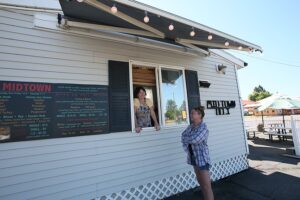
Midtown Drive Up Deli owner Mikele Williams visits with employee Lori Nirk’s daughter, Amanda Flom, before opening for the day. Midtown is in the southeast corner of the My Favorite Things parking lot on Seltice Way in Post Falls. Photo credit: Devin Weeks
Hegsted likens opening a take-out or delivery restaurant through a ghost kitchen to launching a restaurant in an unpopular neighborhood.
“In the beginning, it may be a little more difficult to get people to latch onto the idea of coming to that neighborhood,” he says. “It’s the same with people figuring out the idea that it’s delivery only. But once you get that clientele and build that loyalty, people are willing to get food delivered that they know is going to be good quality.”
Long before the era of COVID-19, Laura Kasbar was a Spokane mother who merely wanted to find a way to address her children’s autism.
Almost by chance, she noticed that video lessons would help, particularly with a child who doctors had declared would never speak.
Nine years later, in 2011, her son Max was mainstreamed, and her Gemiini Systems, still based in Spokane, has become a worldwide leader in online distance learning for people with autism, Down syndrome, dyslexia, speech delay, stroke and other issues.
Since the novel coronavirus outbreak, Gemiini has seen “an avalanche” of interest as families and school districts seek virtual solutions to real-life challenges of learning from home, Kasbar said from her home in Southern California.
The company, with about 50 employees, is run by her son Nicholas out of the Holley- Mason Building in downtown Spokane. After an initial adjustment, Gemiini has adapted to a surge in business.
Gemiini has opened its certification program to professionals and has waived the $490 fee for certification.
Gemiini is also offering schools and clinics the use of its system at no cost as long as they agree to submit the cost of the program to Medicaid.
Gemiini has proven to be a valuable solution for special education administrators, who are struggling to navigate this crisis to continue to meet the needs of special needs students and families.
For many children, “this can be the only link to therapy,” Kasbar said. “And now with COVID everyone is on that boat.
“Our team has been able to get to work immediately. Our subscription base has increased dramatically.”
Gemiini – the unique spelling is Kasbar’s tribute to her autistic twins, Max and Anastasia – was the product of Kasbar’s yearslong search for a solution.

Nicholas Kasbar is ready for a busy day at Gemiini Educational Systems located in the Holley-Mason Building in downtown Spokane. Gemiini Educational Systems, which Kasbar co-founded with his mother Laura, is a video-focused system to teach autistic children. Business is booming for Gemiini since the COVID-19 pandemic sent students home for school.
It was in 2001 that Kasbar recalled walking into a room in her Spokane home, saw all six of her children lined up in front of the television and “couldn’t really tell which were the autistic ones.”
At that time, conventional wisdom dictated the television should be turned off if autistic children were nearby. But that experience told Kasbar video was the answer.
She and her husband Brian had noticed that young Max wouldn’t make eye contact with them but would interact with the television.
“I thought, ‘I’ve got to get my mouth on the TV,’ ” Kasbar said.
That night, they made one-minute videos of a cup and Barney, the TV dinosaur.
“It was a close-up of my mouth saying the word ‘Barney’ next to the actual Barney and then saying the word ‘cup’ next to a cup. We did three sets in a row,” Kasbar said.
That night, after watching several times from his highchair while eating, Max made his biggest breakthrough.
Kasbar held up a cup and he said “cup,” his first word – 3 years and 8 months of age.
During the next decade, and with the help of her oldest son, Nicolas – who also had been on the autism spectrum – Kasbar developed the video program.
In 2012, thanks to funding from the Spokane Angel Alliance and Inland Imaging, Gemiini was launched.
Backed by studies from four universities, Gemiini serves 30,000 clients in 40 countries.
Its use of discrete video modeling, which presents only a specific piece of audio information, was showed by a Portland State University study to be 300% more effective than standard video modeling.
Kasbar was so inspired by the success of her program that she shared her experiences in a book, “Embracing the Battle: Secrets of Victory from a Warrior Mom.”
Closer to home, Gemiini has worked with former NFL star and Spokane native Mark Rypien to develop an application to address suicide prevention.
The goal, Rypien said last fall, is to connect circles of friends of persons at risk so they can better monitor their state of mind.
Lately, the main focus has been reaching children who have been isolated by COVID-19.
“It’s been pretty easy,” said Nicolas, who runs the Spokane headquarters. “After a few headaches, we’ve been able to keep going and helping people, and we’ve updated a lot of our instructions on Facebook Live to walk people through how our lessons work.”
Jim Allen can be reached at (509) 459-5437 or by email at [email protected].
First published in the Journal of Business, June 4, 2020. By Kevin Blocker.
Not even the COVID-19 pandemic has been able to blunt the tide of growth the design-build construction company Verdis is experiencing.
Since becoming a member of the Small Business Administration’s 8(a) Business Development Program in 2016, Verdis has secured 99 federal projects, 19 of which are currently active, says Sandy Young, founder and principal of the Coeur d’Alene-based company.
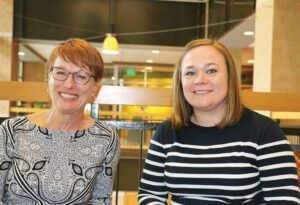
Verdis founder and principal Sandy Young, left, sits with senior planner Stephanie Blalack in the company’s offices in the Parkside Tower, in downtown Coeur d’Alene.
The 8(a) program is a nine-year business development program that provides business training, counseling, marketing, and technical assistance to small businesses that have applied and then been accepted to the program.
Verdis has a greater ability to secure federal work with certifications as both a woman-owned business and an 8(a) operation. The federal government’s goal is to award at least 5% of all federal contracting dollars to small businesses and women- and minority-owned businesses.
Now doing business in 13 western states, Verdis recently secured its largest federal contract to date, an almost $4 million project in Alaska, where Young is from originally.
A 7.1-magnitude earthquake that struck south central Alaska on Nov. 30, 2018, continues to generate engineering and construction repair work through the federal pipeline.
Despite the flourishing federal work, Young says one of the requirements of 8(a) status is to maintain local work in the community. While she declines to disclose the firm’s annual revenue, she says close to a third of all income is generated by local projects.
Deemed as an essential business, Verdis anticipates annual revenue to double in 2020 over 2019. First-quarter revenue alone this year exceeded calendar year 2019, she says.
The company forecasts a nearly four-fold increase in revenue by 2022, compared with 2019 earnings, Young says.
“We’ve been able to self-perform much of our work, which is a big deal for an 8(a),” she says. “Very few firms do both engineering and construction. We seal fish ladders, rip up rails in powerhouses at dams, and restore old buildings and windows.”
With 25 employees, Verdis occupies roughly 2,000-square feet of space in a second-floor suite at Parkside Tower, located at 601 E. Front. It’s the company’s fifth location since its founding in 2007, Young says.
A vice president of construction, Colin Meehan, oversees five project superintendents and six members of a field-personnel team, constituting the firm’s largest concentration of employees.
Young, who is 64, moved to Idaho from Alaska in 1997 and spent the next decade working in Kootenai County’s community development department. Along the way, she met her late husband, Gary, who worked as the director of community development for the city of Post Falls, she says.
The two married in 2006, and the following year, Young says the couple began the process of going into business for themselves.
“He had been in business for himself for a while; he was a licensed landscape architect,” she says. “He’d say, ‘It’s not as easy you think, not every hour is billable.’ I remember sitting on a plane—we were going on a trip somewhere—and telling him, ‘Let’s do it.’’’
In the basement of a building in Post Falls, the couple set up an independent development and planning operation.
“Fortunately, because of our public-sector jobs, people knew us,” she says. “There weren’t many planners around, so we got a few clients right out of the gate.”
Young says the company steadily grew. Landscape architecture work quickly expanded, and Verdis began using subcontractors for civil engineering projects.
In 2012, Verdis was granted woman-owned business status through the SBA, but the business didn’t qualify for the 8(a) program due to the couple’s combined assets, she says.
Then, in 2014, Gary Young contracted cancer and died the following year. It was his death that allowed Verdis to qualify for 8(a) status, she says.
“On his death bed he said, ‘Get the 8(a). I want you to kill it. I don’t want to have to worry about you,’’’ Sandy Young says, fighting back tears.
Reflecting on that time, Young says the business took off as she poured herself into work as way to deal with the grief.
“That wouldn’t have happened if I would’ve had a spouse at home, right?” she asks rhetorically. “Who doesn’t want to be home at night?”
Young says she bought a new car and “hit the road” religiously in an effort to generate new business.
“Honestly, it seemed like such a longshot because you’re sitting there trying to sell your capability, and I really didn’t understand the world I was in,” she says. “We didn’t have any idea how to put a bid together, we didn’t know what we were going to do. We were designers.”
As Young tried to recruit clients, she was asked if Verdis did construction work. Upon answering no, she was met with a consistent message: Come back when you do.
“Three times I heard that. The fourth time I was asked, my answer was, ‘You bet we do,’’’ she says. “I came back and told staff we’re going to figure this out.”
A year later, Verdis secured its first federal contract, a $327,000 Kachess River Bridge project in Cle Elum, Washington, Young says.
Stephanie Blalack, a senior planner with Verdis, has a perspective about Young and the firm, unlike any other employee. She is the company’s first hire.
“I hired Steph out of college (2004) when I still worked for Kootenai County,” Young says. “When I jumped ship, I brought her with me.”
Says Blalack, “She was a phenomenal boss at the county, so when she left in 2007, I was just devastated.”
Seven months later, Young reached out to her with a job offer.
“I was 25, 26, and I’m thinking of leaving my government job? My parents were like, ‘Are you crazy?’’’ says Blalack.
“But I just had this feeling that I knew she was going to make it,” she says. “If it were anybody else, I would not have left my government job.”
Contact author at [email protected] or 509.344.1267
As the dreaded coronavirus rips across the globe, city after city has locked down, transforming urban business centers, suburban malls, and other public spaces into ghost towns. This is not the first time this has happened—since time immemorial, cities have been epicenters of communicable diseases.
No pandemic or plague or natural disaster has killed off “the city,” or humanity’s need to live and work in urban clusters. Not the Black Plagues of the 14th century, or London’s cholera epidemic in the 1850s, or even 1918’s Spanish Flu, which killed tens of millions of people worldwide. That’s because cities’ concentration of people and economic activity—which serves as the motor force for innovation and economic growth—is just too strong.
We will get through this pandemic, too. We will go back to work and school and gather in restaurants and theaters and sports stadiums again. But when we do, cities and their leaders should not simply return to business as usual. Not only does COVID-19 threaten to reappear in subsequent waves if we do not remain vigilant, but there will always be future pandemics to brace against as well.
Our mayors, governors, and community leaders must do whatever is necessary to get their cities back up and running as soon as they safely can. After, we will need plans in place to prepare for future pandemics, and any social or economic lockdowns they necessitate. The federal government must do its part too, with bold and unprecedented programs to bolster the economic situation of our states and cities as well as our workers and business, especially small business.
Getting this response right may be as important as what we are doing today. Below is a 10-point plan based on detailed tracking of the current pandemic and historical accounts of previous ones, presenting some key measures to prepare our cities, economy, and workers for the next phase of the coronavirus crisis and beyond.
- Pandemic-proof airports: Airports are a critical engine of economic development—they cannot be idled indefinitely. We need to make sure they can get up and running again quickly, and that means mobilizing like we did in the wake of the 9/11 terrorist attacks by adding temperature checks and necessary health screenings to the security measures already in place. It also means reducing crowding: Simple things like stanchions or painted lines on floors can promote social distancing in waiting areas. Airports should have large quantities of masks and hand sanitizer available, and airlines will need to reduce their passenger counts and keep middle seats open during future health crises.
- Prepare large-scale civic assets: Cities are also home to other forms of large-scale infrastructure: stadiums, arenas, convention centers, performing arts centers, etc. Because they bring together large groups of people, city leaders must pandemic-proof these assets as much as possible, too. Audience sizes may need to be reduced in theaters, with seats left open. Masks may need to be required and made available to patrons as needed, and temperature checks carried out. This will be critical for communities that are dependent on such attractions: A Brookings analysis shows that COVID-19’s economic downturn will hit tourism-driven cities such as Orlando and Las Vegas hardest. The sooner such large-scale civic infrastructure can be safely reopened, the faster our urban economies will be able to rebound in the aftermath of a pandemic.
- Modify vital infrastructure: As we’ve seen during the first phase of the COVID-19 crisis, buses, subways, and trains need emergency infusions of cash to keep the systems solvent when ridership is low or nonexistent. When they are back in service, design changes in stations and seating will be needed to prevent the spread of infectious diseases. Streets may need some retrofits too; New York Governor Andrew Cuomo has called for pedestrianizing some New York City streets to promote social distancing during COVID-19. Some of these changes should be permanent. Cities need to expand and better protect their bike lanes too, while refining bike- and scooter-sharing programs for when public transit in compromised.
- Ready key anchor institutions: Medical centers, hospitals, and universities are on the front lines of the battle against COVID-19, and many are already overtaxed. With dormitories, dining halls, and large groups of people, they will be highly vulnerable to the secondary waves of contagion. How can we ensure that they can operate safely to carry out vital research during pandemics? Just as with other large-scale civic assets, classes in these institutions can be kept small, but institutions will need to retrofit dormitories and dining halls with temperature checks and ensure adequate social distancing so they can safely function.
- Embrace telework: We are in the midst of a massive experiment in remote work. Most people will eventually go back to their offices, but some workers and companies may find remote work to be more effective. Tulsa, Okla. has leveraged this concept through its Tulsa Remote initiative, which pays remote workers a small grant to relocate there while helping them forge community and civic connections. Cities can learn from one another about how to best support the growing cadre of remote workers and make them connected, engaged, and vital parts of their communities.
- Ensure Main Street survives: The restaurants, bars, specialty shops, hardware stores, and other mom and pop shops that create jobs and lend unique character to our cities are at severe economic risk right now. Some projections suggest that as many as 75% of them may not survive the current crisis. The loss of our Main Street businesses would be irreparable, and not just for the people whose livelihoods depend on them, but for cities and communities as a whole. The places that have protected their Main Streets will have a decisive competitive advantage as we return to normalcy. Loan programs from government, foundations, and the private sector as well as support from small business and technical organizations will be essential for ensuring these businesses survive. Cities need to provide this type of assistance and advice to these vital small businesses so they can safely reopen and weather the storm of future lockdowns.
- Protect the arts and creative economy: The creative economy of art galleries, museums, theaters, and music venues—along with the artists, musicians, and actors who fuel them—is also at dire risk. Cities must partner with other levels of government, the private sector, and philanthropies to marshal the funding and expertise needed to keep their cultural scenes alive. Once they are allowed to reopen, these places will also need to make interim and long-term changes in the way they operate. Cities should provide advice and assistance on necessary procedures—from temperature screenings, better spacing for social distancing, and other safety measures—for these venues to continue as part of the urban landscape.
- Assess leading industries and clusters: It’s not individual firms but clusters of industry and talent that drive economic development. Some of those clusters are at greater risk than others: Sectors such as transportation, travel and hospitality, and the creative arts will be hit the hardest, while e-commerce and distribution or advanced manufacturing for health care and food processing may grow. Cities and economic development organizations must assess the industries and clusters that are most vulnerable in their territory, evaluate the impacts future pandemics will have for their labor markets and communities, and plan to make their economies more resilient and robust. They should pull together cluster working groups of business and non-profit representatives and local academics and experts to best assess the impact of the pandemic and pandemic-related response on key clusters and develop medium-range plans.
- Upgrade jobs for front-line service workers: Nearly half of Americans work in low-wage service jobs. A considerable percentage of them—emergency responders, health care aides, office and hospital cleaners, grocery store clerks, warehouse workers, delivery people—are on the front lines of the pandemic. They need better protection, higher pay, and more benefits. States such as Vermont and Minnesota have paved the way by designating grocery store employees as emergency workers, making them eligible for benefits including free child care. Having a well-paid cadre of front-line service workers who can keep our communities safe and functional will help protect us from future wave of this pandemic and others that may follow.
- Protect less-advantaged communities: The economic fallout of pandemics will hurt most for the least-advantaged neighborhoods and their residents, who lack adequate health coverage and access to medical care, and who are the most vulnerable to job losses. This, too, is a fundamental issue of both safety and equity. Concentrated poverty, economic inequality, and racial and economic segregation are not only morally unjust—they also provide fertile ground for pandemics to take root and spread. Economic inclusion and more equitable development are critical factors for the health, safety, and economic competitiveness of our places. Cities and local leaders can work with federal and state agencies, community development organizations and local foundations to target needed funds, support services and technical assistance ot these areas.
There is light at the end of the tunnel. In the not-too-distant future, the pandemic will end and our cities will return to something approximating normal. What we do over the next 12 to 18 months can ensure that our city and metro economies get up and running again while protecting themselves against similar scenarios in the future. This is a time when our cities and their leaders can and must show the way forward.
Mark Pond received very few questions from visitors about starting a business at the reference desk when he began a career at the Spokane Public Library in 2006.
“I just sat at the downtown library at the reference desk waiting for business questions to come to me. It was complete radio silence,” said Pond, the library’s business reference librarian. “People didn’t know what the library had to offer. I didn’t know how to market what we had to offer, and the tools we had available weren’t necessarily anything close to the toolbox we have now.”

Pond jumped into action and led an effort to provide resources to entrepreneurs at the Spokane Public Library. By 2016, the library’s business offerings had expanded to include the Level Up Coworking Space at the downtown branch that provides meeting rooms, Macs with Adobe Creative software and access to a Bloomberg Terminal.
The Spokane Public Library is the second in the nation – the New York Public Library being other – with a Bloomberg Terminal, which provides access to financial news, analytics and charts.
In addition to providing one-on-one business consultations and conducting workshops on various business topics at local organizations, Pond maintains resources at spokanebusiness.org that help people research market information, find potential customers, develop business plans and take online job-training courses.
“One of the primary drivers in opening up the Level Up Coworking Space is the gig economy. It gives them tools and resources to figure out how to do their jobs,” Pond said. “Having those kinds of ongoing education and learning opportunities for the Spokane workforce can be huge in terms of business retention and expansion.”
Becoming a business research librarian
Pond, a Kettle Falls native, graduated with a master’s degree in library and information science from the University of Washington in 2000. He worked as a reference assistant at the University of Washington library while attending college. After graduation, Pond was hired as a reference librarian for the Seattle Public Library, a position he held for more than six years.
Pond said he was drawn to library work because of the opportunity to help people with a range of questions and subjects.
“One of the things that appealed to me about the library world is – if you want – you can get super specialized, but sometimes just sitting at the reference desk taking whatever questions coming your way is really fascinating,” he said.
Pond and wife, Maggie, contemplated a move back to Eastern Washington in 2006 to be closer to family and raise their two children. Within hours of discussing the potential move, Pond saw a job posting for a business research position at the Spokane Public Library.
Although Pond had some experience with business research while working at the Seattle Public Library, he was a little concerned at first that the position would be too specialized and might not be a good fit.
“But I love it,” he said, adding it’s a combination of specializing in business topics while also providing the opportunity to answer many different questions from a variety of entrepreneurs.
“At the same time, there’s some common threads in the business research world – who you are selling to and what’s your business model. So those things, (the library) can really help them,” he said. “I enjoy being able to work with a whole span of different businesses around town. I find that really fascinating.”
Growing resources
It took more than a decade for Pond to develop business resources for the downtown library branch. He said the idea to improve the offerings was planted when he met a man who created a device that assists with safety checks for tractor-trailers.
Pond shared with the man some of the library’s business research tools and directories, and compiled a list of trucking companies on the West Coast within seconds.
“The guy said he paid $1,800 for the exact same list two days ago,” Pond said. “So, I had a couple of interactions like that for the tools we have. They are in need and of value to the business community.”
Technology has changed how people access information at the library. More people are gravitating toward digital access to books and reference materials, Pond said.
“I realized it will be a thing of the future and thought, ‘I have to get outside of the library and meet businesses on their own terms,’ ” he said.
After Startup Spokane – a program of Greater Spokane Incorporated – launched in 2015, more entrepreneurs began seeking Pond’s assistance for market research.
About half the businesses Pond works with are startups, and he recently assisted teams of students with business research for the upcoming Northwest Entrepreneur Competition.
“Even today, people don’t realize how incredible the resources and options he’s created for startups and small businesses,” said Mark Gustafson, director of innovation and strategy at Avista Corp. and managing partner of Mind to Market LLC. “For a startup, there’s no way they would have access to this rich of a system in their company.”
Mind to Market LLC is a program by Avista that connects startups with experienced coaches to prepare them for early-stage investments.
Mind to Market participants find business resources – especially PitchBook – useful at the library, Gustafson said.
PitchBook
The Spokane Public Library, with Pond’s help, became the first library in the country to secure a subscription to PitchBook, a venture capital and private equity database.
“Most mom-and-pop businesses in town aren’t looking for venture capital funding, so it doesn’t address them,” Pond said. “But, for the companies that are looking for venture capital funding, it’s really helpful to have the industry standard tool available to them when they come in and consult with me.”
University of Washington’s CoMotion Labs provided grant funds to cover a one-year subscription for PitchBook, totaling more than $18,500 per year.
Pond said the Spokane market and its location in Eastern Washington and proximity to Gonzaga, Whitworth and Washington State universities appealed to PitchBook.
“The universities don’t have a subscription, but I can present it to MBA classes and when they go back to their hometowns, they are aware of PitchBook,” Pond said.
Greater Spokane Incorporated, the Health Sciences & Services Authority of Spokane County and the Spokane Angel Alliance donated more than $13,000 toward a second-year subscription for PitchBook.
“It seems like the library is really well-positioned to be a crowdsourcing hub for access to more resources, even if they might be kind of industry specific, like PitchBook,” Pond said.
A win for the economy
Although the Spokane Public Library’s downtown branch is closed for renovations, Pond is continuing to accept online and phone consultations.
Pond said during the downtown branch closure, the Bloomberg Terminal will be moved to the Spokane Academic Library at the Riverpoint campus.
Prior to Gov. Jay Inslee’s order to restrict gatherings because of the coronavirus pandemic, Pond was holding several meetings at local organizations such as small-business resource SCORE, a volunteer mentorship program, to help people with writing a business plan and other topics.
Pond aims to continue working to provide resources for Spokane businesses and entrepreneurs.
“We are spending $100,000 per year just for business research tools. There’s zero startups anywhere in the nation that are going to spend $100,000 on market research,” he said. “The library can step in and reduce that scope of risk for our local businesses. It’s a win for them and it’s a win for the Spokane economy.”
Among the databases available through the library are:
- Washington State Legal Forms, offering state and federal forms.
- Statista, with market data, market research and market studies.
- Reference USA, with market research, competitive analysis and sales lead generation.
- Microsoft Imagine Academy, with online courses for Microsoft technology.
- Demographics Now, offering demographics, consumer expenditures and interactive maps.
